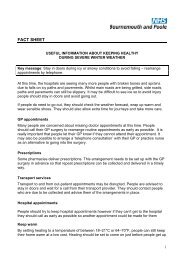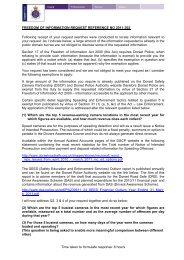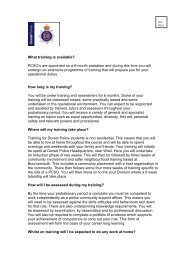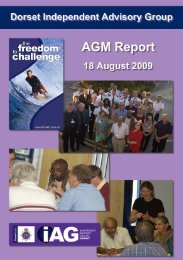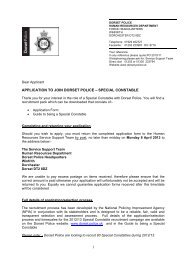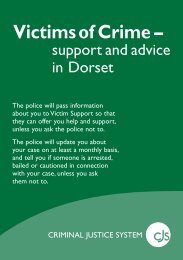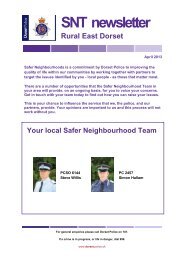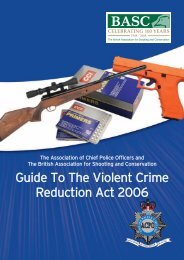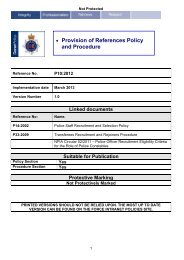P15-2011 Anti-Social Behaviour Policy and Procedure - Dorset Police
P15-2011 Anti-Social Behaviour Policy and Procedure - Dorset Police
P15-2011 Anti-Social Behaviour Policy and Procedure - Dorset Police
Create successful ePaper yourself
Turn your PDF publications into a flip-book with our unique Google optimized e-Paper software.
• <strong>Anti</strong> <strong>Social</strong> <strong>Behaviour</strong> <strong>Policy</strong> <strong>and</strong><br />
<strong>Procedure</strong><br />
Reference No. <strong>P15</strong>:<strong>2011</strong><br />
Implementation date 25 October 2012<br />
Version Number V1.0<br />
Reference No:<br />
Name.<br />
Linked documents<br />
Multi Agency ASB <strong>Policy</strong> for High Risk Victims: (<strong>Dorset</strong> County CSP,<br />
Poole CSP, Bournemouth CSP)<br />
Over arching Information Sharing Protocol (OAISP)<br />
P04:<strong>2011</strong> Hate Crime policy <strong>and</strong> procedure<br />
<strong>Policy</strong> Section<br />
<strong>Procedure</strong> Section<br />
Yes<br />
No<br />
Suitable for Publication<br />
Protective Marking<br />
Restricted<br />
PRINTED VERSIONS SHOULD NOT BE RELIED UPON. THE MOST UP TO DATE<br />
VERSION CAN BE FOUND ON THE FORCE INTRANET POLICIES SITE.
Restricted<br />
Table of Contents<br />
1 <strong>Policy</strong> Section .......................................................................................................................3<br />
1.1 Statement of Intent – Aim <strong>and</strong> Rationale .........................................................................3<br />
1.2 Visions <strong>and</strong> Values ..........................................................................................................7<br />
1.3 Securing Trust <strong>and</strong> Confidence .......................................................................................8<br />
2 St<strong>and</strong>ards ..............................................................................................................................8<br />
2.1 Legal Basis ......................................................................................................................8<br />
2.2 People, Confidence <strong>and</strong> Equality Impact Assessment.....................................................8<br />
2.3 Monitoring / Feedback .....................................................................................................8<br />
3 Consultation <strong>and</strong> Authorisation ..........................................................................................9<br />
3.1 Consultation.....................................................................................................................9<br />
3.2 Authorisation of this version.............................................................................................9<br />
4 Version Control .....................................................................................................................9<br />
4.1 Review .............................................................................................................................9<br />
4.2 Version History ................................................................................................................9<br />
4.3 Related Forms ...............................................................................................................10<br />
4.4 Document History ..........................................................................................................10<br />
ASB <strong>Policy</strong> & <strong>Procedure</strong> <strong>P15</strong>:<strong>2011</strong> V1.0 2
Restricted<br />
1 <strong>Policy</strong> Section<br />
1.1 Statement of Intent – Aim <strong>and</strong> Rationale<br />
These aims are supported by guidance provided within the <strong>Dorset</strong> <strong>Police</strong> ASB procedure<br />
<strong>and</strong> the Multi Agency ASB <strong>Policy</strong> for High Risk Victims.<br />
<strong>Dorset</strong> <strong>Police</strong> aims to:<br />
1. Ensure a clear objective for the prioritisation of competing dem<strong>and</strong>s based upon the<br />
‘Victim, Offender, Communities’ triangle; This triangle is a problem solving tool which<br />
helps teams to focus on defining the problem precisely, having identified the incidents to<br />
be included in the analysis. It is crucial to establish what it is about the place, caller or<br />
victim, <strong>and</strong> the offender or source of the problem that causes it to arise, <strong>and</strong> how <strong>and</strong><br />
when this happens;<br />
2. Ensure a focused service delivery against threat, risk, harm <strong>and</strong> vulnerability; Promote<br />
the use of core performance measurements on which it can be evidenced that <strong>Dorset</strong> is<br />
safer <strong>and</strong> <strong>Dorset</strong> feels safer, utilising performance data produced by DORMIS (<strong>Dorset</strong><br />
<strong>Police</strong> Management of Information System);<br />
3. Promote a consistent ASB procedure, which maps guidance for all relevant staff <strong>and</strong><br />
business areas;<br />
4. Ensure ASB is correctly identified <strong>and</strong> recorded by Contact Management <strong>and</strong> that any<br />
identified crimes are recorded as such <strong>and</strong> dealt with appropriately;<br />
5. Identify repeat <strong>and</strong> vulnerable victims applying a consistent assessment of risk <strong>and</strong> harm<br />
<strong>and</strong> to ensure the effective support <strong>and</strong> resolution of identified problems;<br />
6. Ensure the completion of a risk assessment (Victim Vulnerability Assessment) of<br />
individuals, where appropriate, to establish their vulnerability <strong>and</strong> need for further<br />
partnership engagement <strong>and</strong> to enable partnership solutions;<br />
7. Train relevant staff in responses to ASB. They will receive refresher training when<br />
necessary, including the event of significant legislative change;<br />
8. Work with partners to identify <strong>and</strong> support those victims <strong>and</strong> witnesses who suffer most<br />
harm <strong>and</strong> /or who may be ‘vulnerable’ by use of a Multi Agency Risk Assessment<br />
Conference (case conference) approach to support appropriate cases deemed High<br />
Risk;<br />
9. Work with all partners who will consult <strong>and</strong> lawfully share information with other statutory<br />
agencies, having due regard to the Overarching Information Sharing Protocol, to ensure<br />
an appropriate level of support to victims <strong>and</strong> witnesses of ASB <strong>and</strong> the management of<br />
offenders;<br />
10. Work with partners to ensure perpetrators of ASB receive appropriate intervention within<br />
the criminal justice system. Interventions will vary for each case <strong>and</strong> may include options<br />
such as warning letters, ABCs, ASBOs, CRASBOs <strong>and</strong> ASBIs (injunctions);<br />
11. Ensure effective consultation <strong>and</strong> engagement with our communities <strong>and</strong> partners to<br />
better underst<strong>and</strong> the extent <strong>and</strong> nature of the problems relating to ASB. We will work<br />
ASB <strong>Policy</strong> & <strong>Procedure</strong> <strong>P15</strong>:<strong>2011</strong> V1.0 3
Restricted<br />
with partners in ASB hotspots to explore diversionary <strong>and</strong> educational activities for those<br />
people who are, or are at risk of, offending. Forums including Tasking <strong>and</strong> Co-ordinating<br />
Groups (TCG) <strong>and</strong> Community Safety Partnerships (CSP) will consolidate this aim;<br />
12. Promote the use of positive <strong>and</strong> balanced media releases especially where young people<br />
are concerned. This is managed by the Neighbourhood Inspector <strong>and</strong> the media <strong>and</strong><br />
corporate communications team;<br />
13. Encourage partner <strong>and</strong> voluntary agencies to support our communities to take a st<strong>and</strong><br />
against ASB. The people of <strong>Dorset</strong> also have a role to play in tackling the problems<br />
within their own communities.<br />
Our priority is to make <strong>Dorset</strong> safer <strong>and</strong> feel safer. We will do this by being victim focused,<br />
ensuring that individuals <strong>and</strong> communities are offered the highest st<strong>and</strong>ard of service possible.<br />
<strong>Dorset</strong> <strong>Police</strong> seeks to minimise harm caused, allay community fears <strong>and</strong> achieve sustainable<br />
solutions to ASB related problems by consulting <strong>and</strong> working effectively with partner agencies<br />
<strong>and</strong> the community. We will take action, which is appropriate, consistent, proportionate <strong>and</strong><br />
ethical.<br />
We underst<strong>and</strong> that ASB, the fear of ASB, <strong>and</strong> the perceptions of ASB can have a serious impact<br />
on quality of life for an individual, <strong>and</strong> a community. It creates fear in our neighbourhoods, has a<br />
significant impact on community confidence <strong>and</strong> is often under reported. Consequently callers<br />
who call for the first time have often suffered in silence, or have reported incidents to other<br />
agencies, prior to calling <strong>Police</strong>. In addition, the degree of satisfaction that people have with the<br />
level of service they receive from the police, <strong>and</strong> local authority, can have either a positive or a<br />
negative effect on that person. This experience may influence future decisions regarding<br />
whether or not they report future ASB to an authority.<br />
We take all cases of ASB seriously <strong>and</strong> will work with partners to cohesively <strong>and</strong> robustly solve<br />
problems together, <strong>and</strong> to ensure we put Victims First. Tackling ASB is the responsibility of all<br />
statutory <strong>and</strong> many non statutory agencies. We will work with partners with the intention for<br />
perpetrators of ASB to experience an appropriate intervention within the criminal justice system.<br />
We will ensure a clear objective for the prioritisation of competing dem<strong>and</strong>s based upon the<br />
‘Victim, Offender, Communities’ triangle. When considering the use of any interventions, we will<br />
consider the underlying causes of the ASB. To obtain effective <strong>and</strong> sustainable outcomes we will<br />
consider the benefits of diversionary <strong>and</strong> educational activities.<br />
Definition of <strong>Anti</strong> <strong>Social</strong> <strong>Behaviour</strong> (ASB)<br />
The very definition of ASB presents challenges. Different people possess differing levels of<br />
tolerance <strong>and</strong> expectations around behaviour. It is difficult to ascribe objective values to such a<br />
subjective <strong>and</strong> emotional response.<br />
However clarity <strong>and</strong> consistency around the definition is important in building confidence in the<br />
service. As <strong>and</strong> when we describe ASB rising or falling it is crucial that the public <strong>and</strong> other<br />
stakeholders have confidence in our statements. (Source: ACPO CFBA)<br />
We recognise these challenges <strong>and</strong>, as such, we recognise the following terms which seek to<br />
define ASB:<br />
“<strong>Anti</strong>-social behaviour is any aggressive, intimidating or destructive activity that damages<br />
or destroys another person's quality of life”<br />
Home Office<br />
ASB <strong>Policy</strong> & <strong>Procedure</strong> <strong>P15</strong>:<strong>2011</strong> V1.0 4
Restricted<br />
“That the person has acted in an anti-social manner, that is to say, in a manner that<br />
caused or was likely to cause harassment, alarm or distress to one or more persons not of<br />
the same household as himself”<br />
Crime <strong>and</strong> Disorder Act (1998) – pertaining to <strong>Anti</strong> <strong>Social</strong> <strong>Behaviour</strong> Orders<br />
“If a person is engaging, has engaged or threatens to engage in conduct which is capable<br />
of causing nuisance or annoyance”<br />
Housing Act (1996)<br />
NSIR (National St<strong>and</strong>ards of Incident Recording) Categorisation<br />
ASB in NSIR <strong>2011</strong> reflects a case management ethos rather than an incident based approach. It<br />
considers the level of harm <strong>and</strong> encourages the management of risk with an emphasis on<br />
problem solving for vulnerable persons <strong>and</strong> communities.<br />
NSIR <strong>2011</strong>, categorises <strong>Anti</strong> <strong>Social</strong> <strong>Behaviour</strong> as; Personal; Nuisance; Environmental.<br />
Personal is designed to identify ASB incidents that the caller, call-h<strong>and</strong>ler or anyone else<br />
perceives as either deliberately targeted at an individual or group or having an impact on an<br />
individual or group rather than the community at large. It includes incidents that cause concern,<br />
stress, disquiet <strong>and</strong>/or irritation through to incidents, which have a serious adverse impact on<br />
people’s quality of life.<br />
(Source: NSIR)<br />
Nuisance captures those incidents where an act, condition, thing or person causes trouble,<br />
annoyance, inconvenience, offence or suffering to the local community in general rather than to<br />
individual victims. It includes incidents where behaviour goes beyond the conventional bounds of<br />
acceptability <strong>and</strong> interferes with public interests including health, safety <strong>and</strong> quality of life.<br />
(Source: NSIR)<br />
Environmental deals with the interface between people <strong>and</strong> places. It includes incidents where<br />
individuals <strong>and</strong> groups have an impact on their surroundings including natural, built <strong>and</strong> social<br />
environments. This category is about encouraging reasonable behaviour whilst managing <strong>and</strong><br />
protecting the various environments so that people can enjoy their own private spaces as well as<br />
shared or public spaces.<br />
(Source: NSIR)<br />
Incidents that amount to CRIME must be recorded <strong>and</strong> dealt with as crime in the first<br />
instance.<br />
Managing Vulnerable Victims, Locations <strong>and</strong> Prolific Offenders<br />
Vulnerability<br />
Vulnerability describes the potential to be harmed physically <strong>and</strong>/or psychologically. <strong>Dorset</strong><br />
<strong>Police</strong> recognises <strong>and</strong> adopts the definition:<br />
“A victim of anti social behaviour is vulnerable if the conduct in question causes an<br />
adverse impact on their quality of life. Adverse impact includes the risk of harm;<br />
deterioration of their health, mental <strong>and</strong> or emotional well being; or an inability to carry out<br />
normal day to day routine through fear <strong>and</strong> intimidation.”<br />
ASB <strong>Policy</strong> & <strong>Procedure</strong> <strong>P15</strong>:<strong>2011</strong> V1.0 5
Restricted<br />
(Source: ACPO CFBA)<br />
Vulnerability – Process<br />
Victim Vulnerability Assessments (VVA)<br />
A Victim Vulnerability Assessment (VVA) will be completed to assist with the identification of<br />
repeat <strong>and</strong> vulnerable victims <strong>and</strong> to aide the decision making of <strong>Dorset</strong> police <strong>and</strong> partner<br />
agencies’ practitioners. It should also be used as a guide to help determine what support <strong>and</strong><br />
protection is required, whether partnership intervention is necessary <strong>and</strong> to provide a common<br />
framework.<br />
A VVA is required following an initial complaint; <strong>and</strong> where the attending officer believes this to<br />
be Personal anti social behaviour; <strong>and</strong> a formal VVA will assist in identifying risk to that person (in<br />
support of their professional judgement). Officers will always complete a formal VVA if they<br />
require a structured multi agency approach. Where the full VVA exceeds an identified threshold<br />
(or otherwise in accordance with the professional judgement of the officer dealing with the<br />
complaint) a multi agency case management meeting will be convened with relevant partners.<br />
This formal process must not be allowed to inhibit early partnership interventions <strong>and</strong> provides a<br />
guide for the local frameworks that are in place.<br />
<strong>Dorset</strong> <strong>Police</strong> also employ an initial risk assessment, referred to as ‘TOPIC,’ which is<br />
utilised to identify risk at an early stage, such as telephone reporting.<br />
Managing Vulnerable Victims, Locations <strong>and</strong> Prolific Offenders<br />
The Force Tasking structures <strong>and</strong> processes, <strong>and</strong> Force intelligence provision (ASB ‘focus desk’)<br />
oversee the management of tasking <strong>and</strong> intelligence in relation to vulnerable victims, locations<br />
<strong>and</strong> prolific offenders. Where appropriate this will be undertaken by local Tasking & Coordinating<br />
Groups (TCG).<br />
Harm <strong>and</strong> threat to harm<br />
Harm includes physical damage to property, a financial loss or a reduction in confidence. It also<br />
includes the concept of a “threat to harm”, where we need to consider the capability <strong>and</strong> intent of<br />
the perpetrator versus the resilience of the ‘victim’. Harm is the element we want to remove or<br />
minimise through our interventions. Conflict management model principles can be applied<br />
effectively in certain ASB cases.<br />
<strong>Dorset</strong> <strong>Police</strong> recognises <strong>and</strong> adopts the definition:<br />
“ ‘harm’ is the actual hurt, damage or injury (physical, mental or financial) caused to the<br />
victim or community.”<br />
(Source: ACPO CFBA)<br />
Risk<br />
<strong>Dorset</strong> <strong>Police</strong> recognises <strong>and</strong> adopts the definition:<br />
“The probability of social or personal harm to the victim or community.”<br />
ASB <strong>Policy</strong> & <strong>Procedure</strong> <strong>P15</strong>:<strong>2011</strong> V1.0 6
Restricted<br />
(Source: ACPO CFBA)<br />
Implications of the <strong>Policy</strong><br />
Best Value<br />
The accurate, consistent <strong>and</strong> ethical recording of crimes <strong>and</strong> incidents, in accordance with NSIR<br />
<strong>and</strong> NCRS, provides a critical source of business intelligence. Reliable information, about crimes<br />
<strong>and</strong> ASB incidents, supports effective decision making at strategic, tactical <strong>and</strong> operational levels<br />
<strong>and</strong> thereby enables the best use of resources. This, in turn, will optimise efficiency <strong>and</strong><br />
effectiveness in terms of reducing <strong>and</strong> detecting crime, reducing anti social behaviour <strong>and</strong><br />
maximising customer satisfaction. It is important to identify <strong>and</strong> record ASB accurately. If this is<br />
not done, the wrong symptoms will be identified, leading to the wrong diagnosis <strong>and</strong> ultimately<br />
the wrong prescription.<br />
Staff training<br />
Focused refresher training will be delivered to all relevant staff when it is identified as appropriate<br />
or where there is significant legislative or procedural change. This includes ASB <strong>and</strong> the effects<br />
of threat, risk, harm <strong>and</strong> vulnerability; explanations <strong>and</strong> guidance of NSIR <strong>and</strong> NCRS, in<br />
particular recognising <strong>and</strong> correctly identifying incidents of ASB <strong>and</strong> crime. Each Neighbourhood<br />
Inspector will ensure that there is effective liaison with partner agencies, appropriate exchange of<br />
information <strong>and</strong> management of ASB related issues, appropriate for their neighbourhood.<br />
Risk<br />
Failure to implement this <strong>Policy</strong> will compromise efforts to reduce ASB <strong>and</strong> other problems that<br />
affect quality of life for individuals <strong>and</strong> communities <strong>and</strong> may therefore increase the level of risk<br />
<strong>and</strong> vulnerability to individuals <strong>and</strong> communities. This could, in turn, impact on levels of<br />
confidence in, <strong>and</strong> satisfaction with, policing services. It will undermine efforts for <strong>Dorset</strong> <strong>Police</strong> to<br />
achieve its Policing Priorities <strong>and</strong> will also cause the wasteful deployment of resources <strong>and</strong> bring<br />
into doubt the integrity <strong>and</strong> reliability of performance data. Opportunities to intervene <strong>and</strong><br />
rehabilitate offenders at an early stage of their offending behaviour will be lost.<br />
1.2 Visions <strong>and</strong> Values<br />
<strong>Dorset</strong> <strong>Police</strong> is committed to the principles of “One Team, One Vision” – A Safer <strong>Dorset</strong> for You”<br />
Our strategic priority is to achieve two clear objectives:<br />
• To Make <strong>Dorset</strong> Safer<br />
• To Make <strong>Dorset</strong> Feel Safer<br />
In doing this we will act in accordance with Our Values of:<br />
• Integrity<br />
• Professionalism<br />
• Fairness <strong>and</strong><br />
• Respect<br />
ASB <strong>Policy</strong> & <strong>Procedure</strong> <strong>P15</strong>:<strong>2011</strong> V1.0 7
1.3 Securing Trust <strong>and</strong> Confidence<br />
Restricted<br />
This document seeks to achieve the Priority to Make <strong>Dorset</strong> Feel Safer by Securing Trust <strong>and</strong><br />
Confidence. Research identifies that this is achieved through delivering services which:<br />
1. Addresses individual needs <strong>and</strong> expectations<br />
2. Improve perceptions of order <strong>and</strong> community cohesion<br />
3. Focus on Community Priorities<br />
4. Demonstrate Professionalism<br />
5. Express Force values<br />
6. Instil confidence in staff<br />
2 St<strong>and</strong>ards<br />
2.1 Legal Basis<br />
Section 17 of the Crime <strong>and</strong> Disorder Act 1998, places a requirement on specified bodies<br />
(including the <strong>Police</strong> <strong>and</strong> Local Authorities) to do all they reasonably can to prevent crime <strong>and</strong><br />
disorder in it’s area, including <strong>Anti</strong> <strong>Social</strong> <strong>and</strong> other behaviour adversely affecting the local<br />
environment.<br />
2.2 People, Confidence <strong>and</strong> Equality Impact Assessment<br />
During the creation of this document, this business area is subject to an assessment process<br />
entitled “People, Confidence <strong>and</strong> Equality Impact Assessment (EIA)”. Its aim is to establish the<br />
impact of the business area on all people <strong>and</strong> to also ensure that it complies with the<br />
requirements imposed by a range of legislation.<br />
2.3 Monitoring / Feedback<br />
The ASB reduction officers, within the Community Safety Department, will monitor the application<br />
of the procedure on an ongoing basis <strong>and</strong> formally review annually with due regard to the Force<br />
Control Strategy Delivery Plan. Delivery <strong>and</strong> compliance will be further monitored by the Force<br />
Tasking Groups <strong>and</strong> Force intelligence provision (ASB focus desk), with due regard to core<br />
performance measurements produced by DORMIS (<strong>Dorset</strong> <strong>Police</strong> Management of Information<br />
System),<br />
Feedback relating to this policy can be made in writing or by e-mail to:<br />
Sgt 1639 Goodwin - Territorial Policing – Ian.ison@dorset.pnn.police.uk<br />
ASB <strong>Policy</strong> & <strong>Procedure</strong> <strong>P15</strong>:<strong>2011</strong> V1.0 8
Restricted<br />
3 Consultation <strong>and</strong> Authorisation<br />
3.1 Consultation<br />
Version No: 1.0 Name Rank/Role Date<br />
<strong>Police</strong> & Crime<br />
Commissioner<br />
<strong>Police</strong> Federation C Chamberlain 17/02/2012<br />
Superintendents<br />
Association<br />
Supt M Cooper 17/02/2012<br />
UNISON D Potter 17/02/2012<br />
Other Relevant<br />
Partners<br />
(if applicable)<br />
3.2 Authorisation of this version<br />
Version No: 1.0 Name Rank/Role Date<br />
Prepared: Sgt R Goodwin Oct <strong>2011</strong><br />
Quality<br />
assured:<br />
Authorised:<br />
Chief Inspector P Kessell 19/04/2012<br />
Chief Supt. Martin Hiles<br />
(Comm<strong>and</strong>er Territorial Policing)<br />
19/04/2012<br />
Approved: ACC James Vaughan 19/04/2012<br />
4 Version Control<br />
4.1 Review<br />
Date of next scheduled review Date: 28 February 2013<br />
4.2 Version History<br />
Version Date Reason for Change Created / Amended by<br />
1.0 October Initial Document<br />
Sgt 1639 Goodwin/ Chief<br />
2012<br />
Insp Kessell<br />
ASB <strong>Policy</strong> & <strong>Procedure</strong> <strong>P15</strong>:<strong>2011</strong> V1.0 9
Restricted<br />
4.3 Related Forms<br />
Force Ref. No. Title / Name Version<br />
No.<br />
Review Date<br />
4.4 Document History<br />
Present Portfolio Holder<br />
ACC James VAUGHAN<br />
Present Document Owner<br />
C/INSP. KESSELL<br />
Present Owning Department<br />
ASB TACTICAL SUPPORT TEAM –<br />
Territorial Policing<br />
Details only required for version 1.0 <strong>and</strong> any major amendment ie 2.0 or 3.0:<br />
Name of Board:<br />
OCB<br />
28 FEB 2012 (though later small<br />
Date Approved:<br />
amendments made prior to publication in<br />
Oct 12)<br />
Chief Officer Approving:<br />
ACC Glanville<br />
Template version January 2013<br />
ASB <strong>Policy</strong> & <strong>Procedure</strong> <strong>P15</strong>:<strong>2011</strong> V1.0 10





